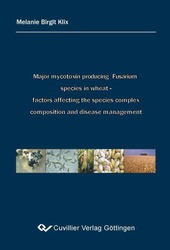| Areas | |
|---|---|
| Serie de libros (96) |
1378
|
| Nachhaltigkeit |
3
|
| Gesundheitswesen |
1
|
| Letra |
2363
|
| Ciencias Naturales |
5406
|
| Matemática | 229 |
| Informática | 319 |
| Física | 980 |
| Química | 1363 |
| Geociencias | 131 |
| Medicina humana | 243 |
| Estomatología | 10 |
| Veterinaria | 108 |
| Farmacia | 147 |
| Biología | 835 |
| Bioquímica, biología molecular, tecnología genética | 121 |
| Biofísica | 25 |
| Nutrición | 45 |
| Agricultura | 1004 |
| Silvicultura | 201 |
| Horticultura | 20 |
| Ecología y conservación de la tierra | 148 |
| Ciencias Ingeniería |
1791
|
| General |
97
|
|
Leitlinien Unfallchirurgie
5. Auflage bestellen |
|
Erweiterte Suche
Major mycotoxin producing Fusarium species in wheat - factors affecting the species complex composition and disease management (Tienda española)
Melanie Klix (Autor)Previo
Indice, Datei (12 KB)
Lectura de prueba, Datei (120 KB)
Fusarium head blight (FHB) infections can significantly reduce yield and quality of the wheat grain, since Fusarium species are known to produce a range of mycotoxins. The most common mycotoxin-producing FHB species in wheat are F. graminearum (teleomorph G. zeae), F. culmorum, F. avenaceum (teleomorph G. avenacea), and F. poae. These species differ in their epidemiology as well as in the range of mycotoxins that they produce. The aim of this study was (i) to determine the effectiveness of plant production methods in reducing contamination of wheat grain by deoxynivalenol (DON), one of the major toxins produced by Fusarium species, (ii) to elucidate the way that wheat cultivation practices and specific environmental conditions influence the FHB species complex composition in wheat, (iii) to identify the Fusarium species in Schleswig-Holstein, and (iv) to determine the effectiveness of triazoles against ascospores, which form the primary inoculum of the most prevalent Fusarium species.
Cultivation of moderately susceptible wheat cultivars (-76+-7%) instead of susceptible ones, proved the most effective method for reducing DON levels in infected wheat grain. Avoiding maize as a previous crop, or using a moldboard plough, reduced DON contents by 67+-11% and 67+-7%, respectively, while the application of triazole fungicides at wheat anthesis reduced DON contents on average by 47+-4%. The frequency of selected mycotoxin-producing Fusarium species in wheat heads was analyzed using Fusarium genus- and species-specific primers. Fusarium graminearum was the species most frequently detected (41%) at 26 sampling sites between 2004 and 2006, followed by F. poae (13%), F. culmorum (12%), and F. avenaceum (9%). The detection frequencies of F. graminearum decreased from the Southeast to the Northwest of the area surveyed. Leaf wetness during the period of wheat anthesis was positively correlated with the detection frequencies of F. graminearum, whereas F. culmorum frequencies were negatively affected. Precipitation, humidity, or temperature did not significantly affect the frequency of any of the Fusarium species studied and neither did the sampling year.
The presence of one, two, and three species co-inhabiting wheat ears was encountered at frequencies of 57%, 19%, and 2%, respectively. However, F. avenaceum and F. poae were found more frequently in combinations with other species than expected. The Fusarium species complex composition was cultivar dependent on three different wheat cultivars (P < 0.01). Cultivation measures, such as tillage and avoidance of specific crops prior to wheat cultivation had no significant effect on the species complex composition.
Gibberella zeae forms airborne ascospores as primary inoculum. The effect of the four triazoles currently registered for FHB control in Germany was tested against ascospores of this species for the very first time. Prothioconazole, the compound released latest to the market, performed best (EC50 0.58 +- 0.19 +- 10-4 M), followed by metconazole (2.14 +- 0.20 +- 10-4 M), and tebuconazole (3.79 +- 0.31 +- 10-4 M). The sensitivity of isolates to triazoles was negatively correlated to the year they were isolated from fields. The sensitivity of G. zeae to metconazole and tebuconazole decreased by a factor of 1.39 during the first 10 years following introduction of these compounds in the market. This decrease was compensated by increased initial efficacy (factor 2.95) within the same period of time. The performance of triazoles against FHB was largely species-dependent. No field resistance of Fusarium species towards triazoles was reported, but resistance has been documented for other fungal species. A common mechanism of fungal resistance towards triazoles encompasses mutations in CYP51, the gene encoding for cytochrome P450 sterol 14α-demethylase, the target site of triazoles in fungal cells. Three copies of the CYP51 gene are present in the genome of F. graminearum. One of these copies (FGSG_010003) was sequenced from isolates with different sensitivity levels towards triazoles, but no differences in the sequence of this gene among the different isolates were observed.
The data presented in this thesis supports the centre of attention on DON in Schleswig-Holstein, although other toxins can be expected as well. FHB epidemics can non-selectively be reduced by cultivation practices, such as tillage and avoidance of specific crops prior to wheat cultivation, followed in an area. In contrast, leaf wetness, application of triazole fungicides, and the use of less susceptible wheat cultivars have a selective effect on specific species and therefore can alter the composition of the species complex on a long term perspective.
| ISBN-10 (Impresion) | 3867274290 |
| ISBN-13 (Impresion) | 9783867274296 |
| ISBN-13 (E-Book) | 9783736924291 |
| Formato | A5 |
| Idioma | Inglés |
| Numero de paginas | 134 |
| Edicion | 1 |
| Volumen | 0 |
| Lugar de publicacion | Göttingen |
| Lugar de la disertacion | Kiel |
| Fecha de publicacion | 22.11.2007 |
| Clasificacion simple | Tesis doctoral |
| Area |
Nutrición
Agricultura |








